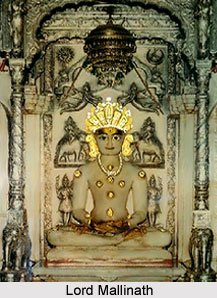 Shri Bhoyani Teerth located in Gujarat is a Jain pilgrimage centre. The teerth Kshetra is in the vicinity of the Bhoyani village situated at a distance of 8 km from Kadi on the Kalol-Bahucharaji way. The temple is dedicated to Lord Mallinath, Nineteenth Jain Tirthankara.
Shri Bhoyani Teerth located in Gujarat is a Jain pilgrimage centre. The teerth Kshetra is in the vicinity of the Bhoyani village situated at a distance of 8 km from Kadi on the Kalol-Bahucharaji way. The temple is dedicated to Lord Mallinath, Nineteenth Jain Tirthankara.
History of Shri Bhoyani Teerth
According to history Shri Bhoyani Teerth dates back to the ancient times. Earlier the place was known as Padamvatinagar. Once there were many Jain temples here but they are now all ruined. Ruins of many Jain idols can also be seen here lying. The place is associated with many legends and miracles. As per a legend the idol of Lord Mallinatha was unearthed from the ground while digging for a well in 1930 of the Vikarm Samvat Era. A beautiful temple was constructed here and the idol was religiously installed on the tenth day of the bright half of the month Maha in V.S. 1943. Devotees from different places visit the temple to offer their prayers. It is said that the lord fulfils all the desires of the pilgrims if prayed with full devotion.
Temple of Shri Bhoyani Teerth
The temple of Bhoyani Teerth is dedicated to Lord Mallinath. The temple is very old and stands as a unique example of ancient art and architecture. It is a magnificent temple decorated and embellished with ancient architectural designs. The artistic designs of the temple boast about the skills of the craftsmen. The idol of the Lord is white in colour and is 104 cm in height. It is seated in a padamasana posture. There are three beautiful peaks that adorn the temple. The temple has an inner apartment and a festival pandal. There are doors on the three sides of the temple. These are embellished with watch-gates that enhance the majesty of the temple. Apart from the main idol there are many other idols installed in the temple. One of the idols here is 3 1/2 ft in height and is looks artistic. It is bekieved that the idol is of Lord Rushabhadeva.
The Temple of Sri Bhoyani Teerth organises many annual gatherings and functions. Every year a fair is held on the tenth day of the bright half of the month of Maha and on the purnima of Shravana. It is organised in memory of the birth of Lord Mallinath. The fair is attended by many pilgrims who come from different places. There are provisions for dharamshalas or rest houses for the pilgrims. These are well equipped with all modern facilities. The temple is surrounded by scenic beauty that attracts and mesmerises the pilgrims. The calm and tranquil environment makes it a suitable place for religious activities. The kshetra is well connected to road, rail and air. Taxi services and bus services are easily available here. The nearest bus stop is located at Bhoyani, Kadi. The nearest railway is situated at Mehsana. The closest airport located here is Ahmedabad.




















